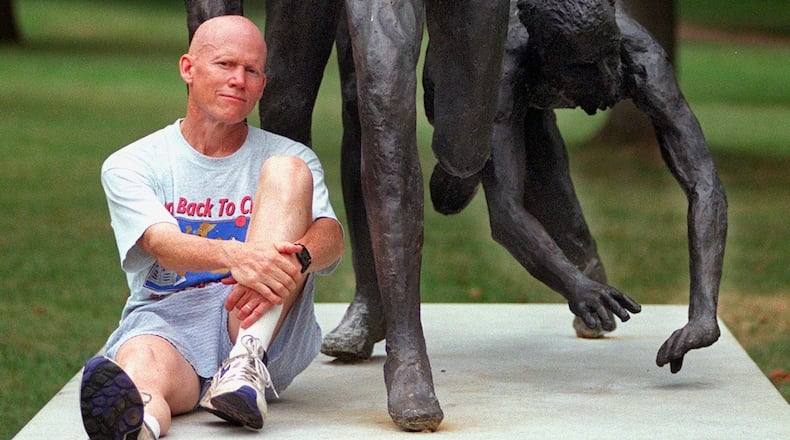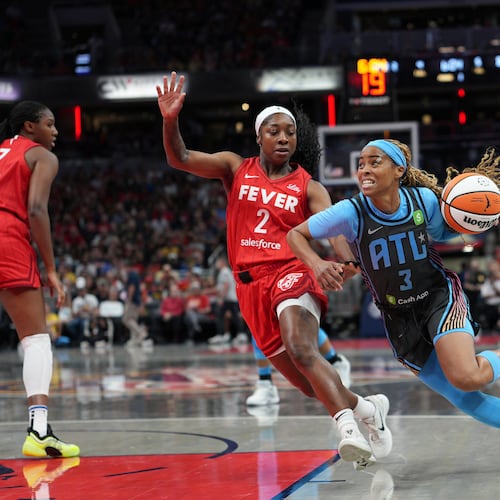It was on a January night in 1978 when Dick Buerkle achieved the accomplishment of a lifetime. At a track meet at Cole Field House at the University of Maryland, Buerkle ran the mile in 3 minutes, 54.93 seconds, a new world record for the indoor mile.
It was an exploration of the boundaries of human possibility, exemplification of a spirit of competitiveness and adventurousness that would never leave Buerkle in a life that breathed its last Monday, when the longtime Atlantan died at the age of 72 after a long battle with a rare neurological disorder.
“I always felt like Dick was trying to improve himself in any way and every way,” said Jean, his wife of almost 49 years. “He always was striving to be better.”
Better and also different. A man who took up running as a high-school senior in Rochester, N.Y., pushed himself to become an All-American at Villanova and then ran the 5,000 meters at the 1976 Olympics in later years went for a run with his wife on an unopened underground section of the MARTA train line and took his daughter for a ride on Ga. 400 – before the roadway officially opened.
“He wanted to experience everything, and he was a person who would rather ask for forgiveness than permission,” his daughter Tera Buerkle said Monday. “He liked to push the boundaries. He taught me to just go anywhere and do anything. Don’t stop until someone makes you stop.”
Tera was the passenger on the Ga. 400 ride.
“It was totally empty, except for me, my dad and his minivan,” she recalled.
Buerkle was gifted and dedicated enough to his sport to be ranked fourth in the world in the 5,000 meters in 1974, crashed the four-minute barrier in the mile six times and graced the cover of Sports Illustrated in February 1978 under the headline “New Master of the Mile.”
He also spent one childhood summer talking in rhyme, his wife said. With his three children, daughters Tera and Lily and son Gabriel, bedtime reading included the book “Alive,” the story of a Uruguayan rugby team that resorted to cannibalism after its plane crashed in the Andes Mountains.
“I think he just thought it was an incredible story and we should hear it,” Lily Buerkle said. “He never sheltered us from anything.”
At a time when American distance running occupied a much larger swath of American sports culture than it does now – populated by stars such as Frank Shorter, Bill Rodgers and Steve Prefontaine – Buerkle (pronounced “berk-lee”) more than held his own. After earning All-America status four times at Villanova, where he arrived as a walk-on, Buerkle was a rival to Prefontaine in the middle-distance realm while he supported himself and his wife by working as a contact-lens salesman.
In 1976, he won the U.S. Olympic Trials in the 5,000, although he failed to advance out of the qualifying heats at the Olympics in Montreal.
“He was a fierce competitor but just a super nice guy,” said Jeff Galloway, founder of the Phidippides running stores, a 1972 Olympian, men’s winner of the first AJC Peachtree Road Race and another American distance-running notable from the era. “And a guy you could just talk to about anything off the competitive track, but watch out on the track.”
Buerkle may have been at his peak between the two Olympiads. After breaking the world indoor-mile mark in January 1978 – he reportedly won after eating nine Oreo cookies and two peanut butter-and-jelly sandwiches a few hours before racing – he won the famed Wanamaker Mile at the Millrose Games in New York two weeks later. That victory netted him the cover of Sports Illustrated on Feb. 6, 1978.
He moved to Atlanta in 1979 to take a job with Coca-Cola as part of an Olympic job-opportunity program and stayed for the next four decades. He had eagerly anticipated his second Olympics, but President Jimmy Carter’s decision to keep the U.S. team home after the Soviet invasion of Afghanistan prevented him from competing.
“I felt like Dick was prepared for 1980 for four years, and it took him four years to recover from that,” his wife said.
Buerkle moved on to other fields. He worked as a TV news reporter, a newspaper reporter (including several years in the ’80s for the AJC), a copier salesman and, most satisfying, a Spanish teacher and coach. He most notably taught and coached at Grady and Dunwoody high schools. His reporting endeavors included an interview while going for a run with Carter.
“That’s kind of when Dick forgave Jimmy Carter because he had a lot of bad feelings,” Jean said.
Buerkle continued to run. He made a habit of celebrating birthdays by running a mile for each year of his new age. He often went on training runs from their family’s Buckhead home to Hartsfield-Jackson International Airport, taking MARTA home while a sweaty mess.
In 1998, he won the masters division of the Peachtree Road Race at the age of 50, 10 years older than his youngest masters competitors. His swiftness had other uses. While dressed up for a family wedding, he successfully chased down a purse snatcher. Another time, he ran across I-85 to rescue his daughter Lily’s hubcap.
“You never appreciate how wide that highway is until your dad is running across it,” Lily said.
Family members believe that his life was molded in part by being a carrier of alopecia, a skin disease that caused his hair to fall out at the age of 12. His children’s earliest memories include their father getting into confrontations with people picking on him because of his bald head. It may have put a chip on his shoulder that spurred him to athletic greatness and a strong sense of self.
It did have one benefit. Jean, who was a student at Villanova at the same time as Dick, took a liking to his look.
“I saw this bald-headed guy running around campus and had a secret crush on him for a couple years,” Jean said.
The torment continued, the family said, until Michael Jordan popularized the look.
Buerkle was wearing an Air Jordan track suit Monday when he died after a long battle with multiple system atrophy.
“He was something else,” Lily said. “I can’t explain it.”
About the Author
Keep Reading
The Latest
Featured



